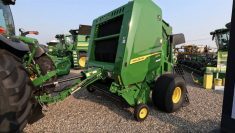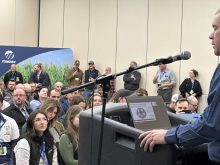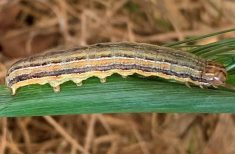When Garry Richards left his job as a pharmacist and brought his wife home to his family farm near Bangor, Sask., in the late ’90s, he had one main goal. “We wanted to make the farm work, so that we didn’t have to subsidize it from off-farm jobs in the long term.” He didn’t expect it to be easy. At that time, he says, “It was about break-even grain farming in our area.”
The Richards family has made it work. Now he, his wife, and their three kids are all passionate about their business, Richards Family Farm and Livestock Ltd. “There is a different way to do agriculture,” he told participants at Upland Organic’s cover crop field day near Wood Mountain in July, an event sponsored by the Old Wives Watershed Association and SaskOrganics.
Read Also

Claas brings 1000 Series SP forage harvesters to Canada
In mid-August, Claas unveiled its new line of Jaguar forage harvesters at an event in Visalia, California, deep in the heart of that state’s dairy region.
From there to here
Richards originally moved home to an 1,800 acre grain farm. Today, he’s running a 4,000 acre grain and livestock farm made up of 1,500 seeded acres, 2,000 acres of perennial forage and 500 acres of native pasture.
In 2003, after Richards and his wife took a holistic management course from Don Campbell, a rancher from Meadow Lake, Sask., they began to look at their farm differently. Returning home after the course and seeing the business with fresh eyes, Richards said, he came to realize that “the wealth is in the land.”
“I had just got into cattle,” he said, “and I thought I was in the cattle business. But I realized that money came from my grass. I was now a grass farmer.”
- Read more: What is holistic management?
He made some changes to the way he managed his land, and kept learning. In the mid-2000s, Richards attended a holistic grazing conference where he had a chance to learn from North Dakota rancher Gabe Brown, a well-known name in holistic management circles.
Coming home from the course, Richards was even more enthusiastic about evolving his farm practices. “I realized that I needed to make my soil healthy.” After this course, Richards was focused on his soil, not just the grass he could grow on it. “At that point I became a dirt farmer.”
Richards believes healthier land brings many benefits. In healthy soil, he said, micronutrients are more available to plants. Healthy soils, he said, are more drought- and flood-proofed, due to healthy soil’s increased capacity to hold water. Even after going through a wet season where other farmers use scrapers and backhoes to get rid of excess water, Richards said, “I’ve chosen to try and turn my land into a sponge. I see water as a valuable resource.”
Growing cover crops and perennial forages is a big part of Richards’ soil health plan. It “inhibits weed growth, slows evaporation…, increases water infiltration, feeds soil microbes and moderates soil temperatures.”
His rule of thumb? “You never want a raindrop to come down and hit bare soil. That’s when erosion occurs.”
Microbes in the soil need to eat, Richards said. But, he said, by mid- to late-September, there aren’t many green plants growing in most fields. “If nothing is growing there, it’s not producing food for the microbes.”
With healthy soil, Richards believes he can lower his input costs and keep his farm profitable. He also sees it as a way to lower his risk, making his farm more resilient to change and more stable in the long run.
Richards shared some of his holistic management practices:
1. “Keep the ground covered.” In nature, Richards said, the ground is always covered. Where there is a bare spot, weeds will grow to fill it. “Weeds are nature’s scab.”
2. “Maintain diversity in your cropping rotation.” Most prairie farmers are working with a monoculture. “You don’t see that in nature. You see polycultures.”
3. “Do not turn the soil.” For organic farmers, Richards said, this practice is challenging, if not impossible. “I’d love to be organic,” he said. “I just don’t want to till. I would sooner spray. To me, it’s the lesser of two evils for soil health.” Tillage, Richards said, is harmful to microbes in the soil. “Nature doesn’t till. I don’t think I should.”
4. “Agriculture was never meant to be done without livestock.” Richards thinks of livestock as both the cattle above the ground and the life in the soil.
The plan in practice
Richards shared the story of one of the fields that showcases his practices.
2013: Cover crop
In 2013, Richards seeded a cover crop blend. This particular blend included: one pound of turnip seed; one pound radish; two pounds buckwheat; two pounds sunflower; five pounds millet; 25 pounds peas, two pounds annual ryegrass; 25 pounds oats; and half a pound red clover.
Because he likes to seed a diverse mix that blends tall and short crops, crops with different leaf shapes and crops that perform different functions on the soil, this was a fairly typical mix.

And, in 2013, he also added some additional biannual seed: 40 pounds of winter triticale; two pounds of hairy vetch; four pounds of sweet clover and four pounds of perennial rye grass.
Richards planned to let these crops establish in the first year, then produce in 2014.
He mixed his own seed blend using a mix of pails and bags. “By the time I run it up into my air tank, it’s mixed.” Because smaller seeds will migrate down, Richards separates the blend, putting small seeds in one tank on the seeder, and bigger seeds in his second tank.
He also added a small amount of fertilizer, and some granular inoculant for the peas.

In mid-August, he set up a temporary fence and put some cattle out to graze. He allowed the cows about one day of grazing at a time, so they could only graze the top half. The other half of the crop mix was trampled into the soil along with the manure. “That fed the livestock below the ground.” Then, he moved the cows along to another part of the field.
2014: Biannual production
In 2014, the biannuals launched into production, primarily the sweet clover. “We silaged off eight metric tonnes,” Richards said. “After that, we had good moisture, and it just regrew.” That allowed Richards’ cattle another 20 grazing days per acre.
In mid-September he pulled the cows off, sprayed the field with a litre of glyphosate, then seeded winter triticale and hairy vetch. He fertilized with 30 pounds of nitrogen, 25 pounds of phosphorus and five pounds of sulfur, but didn’t use herbicide or fungicide. In between the 10-inch rows, he said, “it was black, which I don’t like.” There were no weeds, and the microbes in the soil had consumed the trash on top of the soil between the row.
The crop established nicely.
2015: winter triticale
Last year, Richards grew a healthy stand of winter triticale with little disease or weeds. After harvest, cover crops volunteered. He got another 20 grazing days out of the field, with cows filling up on red clover, hairy vetch, winter triticale, annual ryegrass and a few weeds.

2016: canola
As Richards seeded canola this spring, he looked back and saw what he described as soft lumps behind the seeder — the winter triticale roots. “It was almost like sod,” he said. He considered this a sign of very healthy soil.
“In three to five years,” he said, “you can make significant changes in your soil.”
In a follow-up conversation in September, Richards reported that the canola he grew on this land yielded 52 bushels per acre, while the canola he grew on nearby fields with more traditional rotations yielded nine bushels less. Richards says all of his canola crops received the same amount of fertilizer. He attributes this higher yield to better soil health.
The big picture
Richards pointed out three more benefits to the rotation he used in this field. First, he believes cover crops can help slow the development of herbicide resistance. As he put it, weeds can’t develop resistance to “steel or cows.”
Second, using this rotation, Richards only had to seed three years out of four. This saved money, wear and tear on machinery and best of all, time. With less work in the seeding season, Richards was less stressed.
Finally, the extra profit from the grazing opportunities adds extra profit to his farm operation.
If you’re thinking of making changes on your farm, Richards recommends:
- Learning as much as you can through courses, talking to experienced farmers, and seeking out credible sources on the Internet.
- Thinking long term. He recommends farmers consider their rotations three to five years out, and said, “Oftentimes we think 10 years out.”
- Getting livestock. If you don’t want your own, consider custom grazing or borrowing your neighbour’s cows to reap the benefits.
- Change at a reasonable pace. “Do not go cold turkey off fertilizer,” Richards said. “Your soil is depleted. There’s not the microbiology there to just pick up the slack.” And, he said, “if you’re trying to go organic, it might take a few years.”
- Consider all of your tools. Richards sees chemicals as a tool, but not necessarily a first line of defense against weeds. “I’ve got a bunch of other tools before I have to reach for the jug,” he said. “But it is there when I need it.
Richards finds holistic farming rewarding. By working with nature, he believes he’s saving time in the field, and lowering input costs. However, he says, it takes a lot of management. “You’re going to be at your desk a lot more.”















